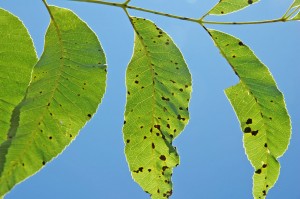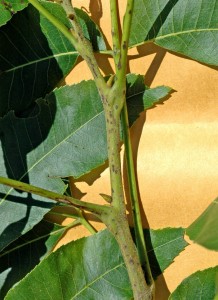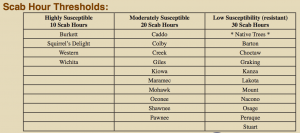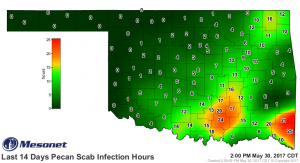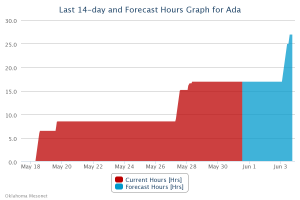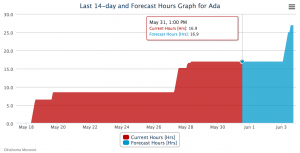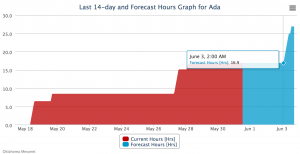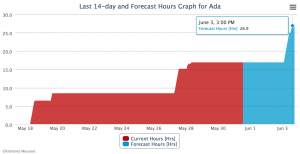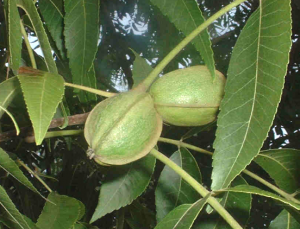When warm nighttime temperatures overlap times of high moisture, pecan scab spores have a good environment to commence their attack. In Oklahoma, we often see these weather conditions in late May and early June.
(Photo: Leaf with pecan scab (William Reid/Northern Pecans)
Spores released in the spring can infect leaves and young stems. This begins the growing season cycle of pecan scab infection. Spores germinate to enter tender leaf, stem, and nutlet tissue. Fungal hyphae grow inside leaves and stems to produce more spores that infect more leaves, stems, and nuts.
(Photo: Leaf with pecan scab (William Reid/Northern Pecans)
Weather conditions are right for fungal infection when the air temperature rises above 70 degrees and the humidity climbs above 90 percent. The accumulation of these hours is know as pecan scab infection hours. By monitoring weather conditions that are conducive for disease infection over the last 14 days, we can determine the best time to apply a fungicide for pecan scab control.
Pecan varieties vary in their susceptibility to fungal attack. Native trees have low susceptibility. Improved varieties vary from low to high pecan scab susceptibility.
(From: How to Use Pecan Scab Advisor (Oklahoma Mesonet and Oklahoma State University)
The Oklahoma Mesonet has a Pecan Scab Advisor to monitor air temperatures and humidities across Oklahoma. To control pecan scab on highly susceptible varieties, plant pathologists recommend applying a labeled fungicide after 10 pecan scab hours have accumulated. The recommendation for moderately susceptible varieties is 20 hours. For native pecans and low susceptible varieties the recommendation is to apply a fungicide after 30 pecan scab hours.
The Mesonet Pecan Scab Advisor has a 14-day statewide map, updated hourly.
You can also look at the accumulation of pecan scab hours for individual Mesonet sites. The reddish graph line is past pecan scab hours. The blue area is forecasted pecan scab hour accumulation. Ada provides an excellent example of how during times of optimum conditions pecan scab hours collect quickly. On the graph, that is when the accumulation number is climbing. When the graph line levels off conditions are not conducive to further disease development.
The graph can be used to monitor disease risk. This graph for Ada was from May 31, 2017 at 1:00 PM. It shows that for Ada there was 16.9 pecan scab hours over the last 14 days. This number of hours is over the application threshold of 10 hours for highly susceptible varieties, but under the threshold for moderate and highly susceptible varieties.
The forecast part of the graph let’s you anticipate the risk of accumulating more pecan scab hours. Fungicides work best when they are applied ahead of plant disease risk. After infection has occurred, fungicides are much less effective. In the graph from Ada, the forecast indicates the next period of pecan scab hour accumulation will begin on June 3, 2017 at 2:00 AM.
After this forecasted warm, wet period through June 3, 2017 at 3:00 PM, the accumulation jumps by 10 hours to 26.9 pecan scab hours. That means the best time to protect moderately susceptible varieties would be to apply a fungicide no later than June 2nd.
Good pecan scab control is one of the keys to producing good quality pecans.
